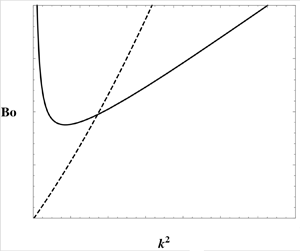Article contents
Branching behaviour of the Rayleigh–Taylor instability in linear viscoelastic fluids
Published online by Cambridge University Press: 17 March 2021
Abstract

The Rayleigh–Taylor instability of a linear viscoelastic fluid overlying a passive gas is considered, where, under neutral conditions, the key dimensionless groups are the Bond number and the Weissenberg number. The branching behaviour upon instability to sinusoidal disturbances is determined by weak nonlinear analysis with the Bond number advanced from its critical value at neutral stability. It is shown that the solutions emanating from the critical state either branch out supercritically to steady waves at predictable wavelengths or break up subcritically with a wavelength having a single node. The nonlinear analysis leads to the counterintuitive observation that Rayleigh–Taylor instability of a viscoelastic fluid in a laterally unbounded layer must always result in saturated steady waves. The analysis also shows that the subcritical breakup in a viscoelastic fluid can only occur if the layer is laterally bounded below a critical horizontal width. If the special case of an infinitely deep viscoelastic layer is considered, a simple expression is obtained from which the transition between steady saturated waves and subcritical behaviour can be determined in terms of the leading dimensionless groups. This expression reveals that the supercritical saturation of the free surface is due to the influence of the normal elastic stresses, while the subcritical rupture of the free surface is attributed to the influence of capillary effects. In short, depending upon the magnitude of the scaled shear modulus, there exists a wavenumber at which a transition from saturated waves to subcritical breakup occurs.
JFM classification
- Type
- JFM Papers
- Information
- Copyright
- © The Author(s), 2021. Published by Cambridge University Press
References
REFERENCES
- 4
- Cited by





